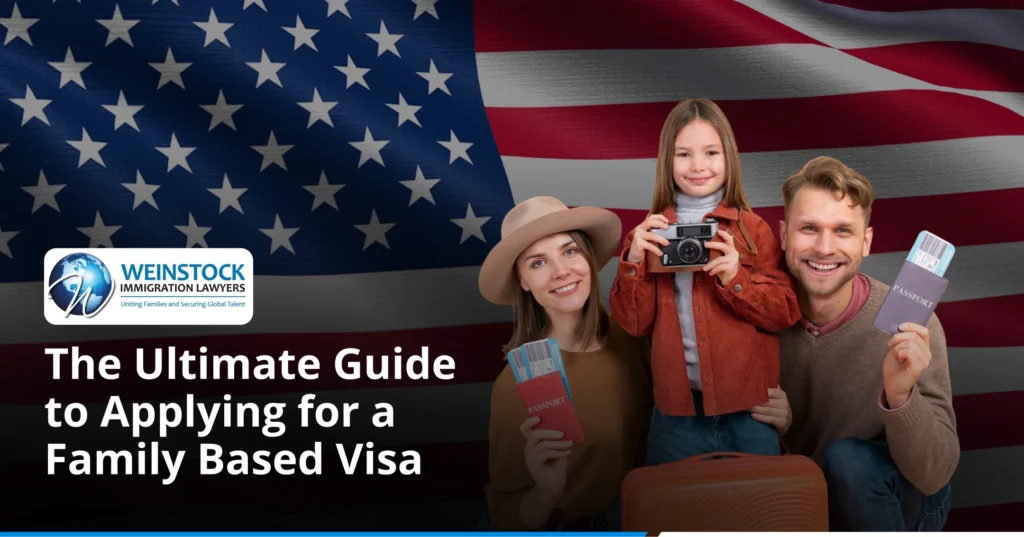Summary
Reuniting with family in the U.S. involves navigating the family-based immigration process, which allows U.S. citizens and lawful permanent residents (LPRs) to sponsor eligible relatives for a Green Card. This guide explains the two main visa categories—Immediate Relative (IR) and Family Preference (F) visas—along with eligibility requirements, step-by-step application instructions, necessary documentation, and common pitfalls to avoid. Learn how to file. Form I-130, complete consular processing or adjustment of status, and track wait times to successfully bring your loved ones to the U.S.
Navigating the U.S. immigration system to reunite with family members can be complex. This guide breaks down the family-based visa process, helping you understand eligibility, application steps, required documents, and common challenges.
Understanding Family-Based Visas
Family-based visas allow U.S. citizens and lawful permanent residents (LPRs) to sponsor certain relatives for permanent residency (Green Card). These visas fall into two main categories:
-
- Immediate Relative (IR) Visas: For close family members of U.S. citizens, including spouses, unmarried children under 21, and parents. These visas are not subject to annual caps, allowing for faster processing.
-
- Family Preference (F) Visas: For other eligible family members, such as unmarried adult children, married children, and siblings of U.S. citizens, as well as spouses and unmarried children of LPRs. These visas have annual numerical limits, leading to longer wait times.
Eligibility Criteria
Who Can Sponsor?
-
- U.S. Citizens: Can sponsor spouses, children (married or unmarried), parents, and siblings.
-
- Lawful Permanent Residents: Can sponsor spouses and unmarried children.
Who Can Be Sponsored?
-
- Immediate Relatives: Spouses, unmarried children under 21, and parents of U.S. citizens.
-
- Family Preference Categories:
-
- F1: Unmarried adult children of U.S. citizens.
-
- F2A: Spouses and unmarried children under 21 of LPRs.
-
- F2B: Unmarried adult children of LPRs.
-
- F3: Married children of U.S. citizens.
-
- F4: Siblings of U.S. citizens.
Step-by-Step Application Process
1. Filing Form I-130: Petition for Alien Relative
The sponsoring relative initiates the process by submitting Form I-130 to U.S. Citizenship and Immigration Services (USCIS). This form establishes the qualifying relationship between the sponsor and the beneficiary.
Required Documents:
-
- Proof of U.S. citizenship or LPR status.
-
- Evidence of the family relationship (e.g., birth or marriage certificates).
-
- Filing fee (as of 2025, $535).
2.USCIS Processing:
USCIS reviews the petition, which may take several months. Processing times vary based on the service center and case complexity. For example, as of early 2025, the average processing time for Form I-130 filed by U.S. citizens is approximately 14.4 months.
3. National Visa Center (NVC) Processing:
Once USCIS approves the petition, the case moves to the NVC for further processing. The NVC assigns a case number and requests additional documentation, including:
-
- Form DS-260 (Immigrant Visa Application).
-
- Civil documents (e.g., birth certificates, police certificates).
-
- Affidavit of Support (Form I-864) from the sponsor.
-
- Visa application fees.
4. Consular Processing or Adjustment of Status:
-
- Consular Processing: If the beneficiary is outside the U.S., they will attend an interview at a U.S. embassy or consulate in their home country.
-
- Adjustment of Status (AOS): If the beneficiary is already in the U.S., they may apply to adjust their status to permanent resident by filing Form I-485. As of early 2025, the average processing time for family-based Form I-485 applications is approximately 9.5 months
5. Medical Examination and Interview:
The beneficiary must undergo a medical examination by an authorized physician. During the interview, a consular officer or USCIS officer will assess the authenticity of the relationship and the eligibility of the applicant.
6. Visa Approval and Entry to the U.S.:
Upon approval, the beneficiary receives an immigrant visa and can travel to the U.S. After entry, they will receive they’re Green Card by mail.
Required Documentation Checklist
For the Sponsor:
-
- Proof of U.S. citizenship or LPR status.
-
- Form I-864, Affidavit of Support, demonstrating the ability to financially support the beneficiary.
For the Beneficiary:
-
- Valid passport.
-
- Birth certificate.
-
- Police certificates from all countries where they have lived for more than six months since age 16.
-
- Medical examination results.
Common Challenges and How to Avoid Them
Incomplete or Incorrect Documentation
Submitting incomplete forms or incorrect information can lead to delays or denials. Ensure all forms are filled out accurately and all required documents are included.
Long Wait Times for Family Preference Categories
Family preference categories are subject to annual caps, leading to extended wait times. For example, as of early 2025, the average processing time for Form I-130 filed by LPRs is approximately 35 months. Regularly check the Visa Bulletin to monitor priority dates.
Failure to Respond to Requests for Evidence (RFEs)
USCIS may issue RFEs if additional information is needed. Timely and complete responses are crucial to avoid further delays.
FAQs
Processing times vary based on the visa category and the beneficiary’s location. Immediate relatives typically experience shorter wait times, while family preference categories may take several years.
Beneficiaries in the U.S. may apply for work authorization while their adjustment of status application is pending.
In certain cases, USCIS may allow the petition to continue through a process called “humanitarian reinstatement.”
Yes, you can appeal or file a motion to reopen or reconsider the decision, depending on the circumstances.
Final Thoughts
Applying for a family-based visa involves multiple steps and careful attention to detail. Understanding the process, preparing accurate documentation, and staying informed about processing times can help ensure a smoother experience. For personalized assistance, consider consulting with an immigration attorney to navigate the complexities of the U.S. immigration system.

